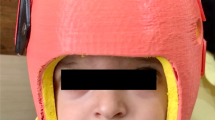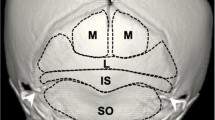Abstract
Purpose
To examine the presence and characteristics of cranial vault suture closure in Chinese adults and to explore whether craniosacral therapy (CST) manipulation is rational from the anatomical perspective.
Methods
Anthropological non-metric observation and craniometry were used to study 285 dry skull specimens of Chinese adults.
Results
A total of 91 specimens with closed extracranial sutures were observed, with an occurrence rate of 31.93%. Based on the mode of closure, there were 32 cases of single type closure, with sagittal suture closure predominating with 20 cases (21.98%); 59 cases of composite closure, with a partial closure of coronal suture + sagittal suture + lambdoid suture predominating with 26 cases (28.57%). In terms of the degree of closure, there were 13 cases (14.28%) of sagittal suture grade 0 closure and 78 cases (85.72%) of grade 1 – 4 closure; 34 cases (37.36%) of coronal suture grade 0 closure and 57 cases (62.64%) of grade 1 – 4 closure; 47 cases (51.65%) of lambdoid suture grade 0 closure and 44 cases (48.35%) of grade 1 – 4 closure. The segment and degree of coronal suture closure (46, 80.7%) and lambdoid suture (31, 70.45%) were mostly left–right symmetrical. The bone surfaces on either side of the cranial vault sutures are embedded in each other, forming a rough, complex and interlocking bone–suture–bone structure.
Conclusion
This study observed the closure of the cranial vault suture, summarized its characteristics, and explored the irrationality of the CST manipulation. The anatomical characteristics of the cranial suture dictate that manipulation cannot push the cranial suture at will.





Similar content being viewed by others
Availability of data and material
The data sets supporting the results of this article are included within the article and its additional files.
Code availability
Not applicable.
Abbreviations
- CST:
-
Craniosacral therapy
- S1:
-
Pars bregmatica
- S2:
-
Pars vertis
- S3:
-
Pars obelica
- S4:
-
Pars lambdica
- C1:
-
Pars bregmatica
- C2:
-
Pars complicate
- C3:
-
Pars pterica
- L1:
-
Pars lambdica
- L2:
-
Pars media
- L3:
-
Pars asterica
- b:
-
Brebma
- l:
-
Lambda
- sph:
-
Sphenion
- ast:
-
Asterion
References
Barbeito-Andrés J, Bonfili N, Nogué JM, Bernal V, Gonzalez PN (2020) Modeling the effect of brain growth on cranial bones using finite-element analysis and geometric morphometrics. Surg Radiol Anat 42(7):741–748. https://doi.org/10.1007/s00276-020-02466-y
Castejón-Castejón M, Murcia-González MA, Martínez Gil JL et al (2019) Effectiveness of craniosacral therapy in the treatment of infantile colic. A randomized controlled trial. Complement Ther Med 47:102164. https://doi.org/10.1016/j.ctim.2019.07.023
Cirpan S, Magden AO, Mas NG, Edizer M, Aksu F, Yonguc GN (2017) The morphological grading and comparison of sutural patency among cranial sutures in dry human skulls. J Craniofac Surg 28(8):2155–2158. https://doi.org/10.1097/SCS.0000000000004011
Di Pietro L, Barba M, Prampolini C et al (2020) GLI1 and AXIN2 are distinctive markers of human calvarial mesenchymal stromal cells in nonsyndromic craniosynostosis. Int J Mol Sci. https://doi.org/10.3390/ijms21124356
Downey PA, Barbano T, Kapur-Wadhwa R, Sciote JJ, Siegel MI, Mooney MP (2006) Craniosacral therapy: the effects of cranial manipulation on intracranial pressure and cranial bone movement. J Orthop Sports Phys Ther 36(11):845–853. https://doi.org/10.2519/jospt.2006.36.11.845
Fan F, Tu M, Li R et al (2020) Age estimation by multidetector computed tomography of cranial sutures in Chinese male adults. Am J Phys Anthropol 171(3):550–558. https://doi.org/10.1002/ajpa.23998
Flynn TW, Cleland JA, Schaible P (2006) Craniosacral therapy and professional responsibility. J Orthop Sports Phys Ther 36(11):834–836. https://doi.org/10.2519/jospt.2006.0112
Garvin HM, Passalacqua NV (2012) Current practices by forensic anthropologists in adult skeletal age estimation. J Forensic Sci 57(2):427–433. https://doi.org/10.1111/j.1556-4029.2011.01979.x
Haller H, Dobos G, Cramer H (2021) The use and benefits of Craniosacral Therapy in primary health care: a prospective cohort study. Complement Ther Med 58:102702. https://doi.org/10.1016/j.ctim.2021.102702
Haller H, Lauche R, Sundberg T, Dobos G, Cramer H (2019) Craniosacral therapy for chronic pain: a systematic review and meta-analysis of randomized controlled trials. BMC Musculoskelet Disord 21(1):1. https://doi.org/10.1186/s12891-019-3017-y
Harrison RE, Page JS (2011) Multipractitioner Upledger Craniosacral Therapy: descriptive outcome study 2007–2008. J Altern Complement Med 17(1):13–17. https://doi.org/10.1089/acm.2009.0644
Hartman SE, Norton JM (2002) Craniosacral therapy is not medicine. Phys Ther 82(11):1146–1147
Jäkel A, von Hauenschild P (2012) A systematic review to evaluate the clinical benefits of craniosacral therapy. Complement Ther Med 20(6):456–465. https://doi.org/10.1016/j.ctim.2012.07.009
Mehl-Madrona L, Kligler B, Silverman S, Lynton H, Merrell W (2007) The impact of acupuncture and craniosacral therapy interventions on clinical outcomes in adults with asthma. Explore 3(1):28–36. https://doi.org/10.1016/j.explore.2006.10.003
Meindl RS, Lovejoy CO (1985) Ectocranial suture closure: a revised method for the determination of skeletal age at death based on the lateral-anterior sutures. Am J Phys Anthropol 68(1):57–66. https://doi.org/10.1002/ajpa.1330680106
Nikolova S, Toneva D, Georgiev I, Lazarov N (2019) Sagittal suture maturation: Morphological reorganization, relation to aging, and reliability as an age-at-death indicator. Am J Phys Anthropol 169(1):78–92. https://doi.org/10.1002/ajpa.23810
Nikolova S, Toneva D, Lazarov N (2021) Squamous suture obliteration: frequency and investigation of the associated skull morphology. Anat Sci Int 96(1):42–54. https://doi.org/10.1007/s12565-020-00555-x
Ruengdit S, Troy Case D, Mahakkanukrauh P (2020) Cranial suture closure as an age indicator: a review. Forensic Sci Int 307:110111. https://doi.org/10.1016/j.forsciint.2019.110111
Standring S (2020) Gray’s anatomy e-book: the anatomical basis of clinical practice, 42nd edn. Elsevier, Amsterdam
von Peter S, Ting W, Scrivani S et al (2002) Survey on the use of complementary and alternative medicine among patients with headache syndromes. Cephalalgia 22(5):395–400. https://doi.org/10.1046/j.1468-2982.2002.00376.x
Walter SD, Eliasziw M, Donner A (1998) Sample size and optimal designs for reliability studies. Stat Med 17(1):101–110. https://doi.org/10.1002/(sici)1097-0258(19980115)17:1%3c101::aid-sim727%3e3.0.co;2-e
Acknowledgements
The authors sincerely thank those who donated their bodies to science so that anatomical research could be performed. Results from such research can potentially increase mankind's overall knowledge that can then improve patient care. Therefore, these donors and their families deserve our highest gratitude.
Funding
The authors have no support or funding to report.
Author information
Authors and Affiliations
Contributions
JHL: Project development, Data Collection, Manuscript writing; ZJC: Project development, Data Collection; WXZ: Project development, Data Collection; HY: Data analysis; YKL: Review and double check.
Corresponding author
Ethics declarations
Conflict of interest
The authors have no conflicts to disclose.
Consent to participate
Ethical approval for this study was obtained from the Chinese Ethics Committee of Registering Clinical Trials (Reference Number: ChiECRCT20210191). All methods in the study were carried out in accordance with the Helsinki Guidelines and Declaration.
Consent for publication
Not applicable.
Additional information
Publisher's Note
Springer Nature remains neutral with regard to jurisdictional claims in published maps and institutional affiliations.
Rights and permissions
About this article
Cite this article
Li, J., Chen, Z., Zhong, W. et al. A study of 285 cases of cranial vault suture closure in Chinese adults. Surg Radiol Anat 44, 361–368 (2022). https://doi.org/10.1007/s00276-021-02854-y
Received:
Accepted:
Published:
Issue Date:
DOI: https://doi.org/10.1007/s00276-021-02854-y




